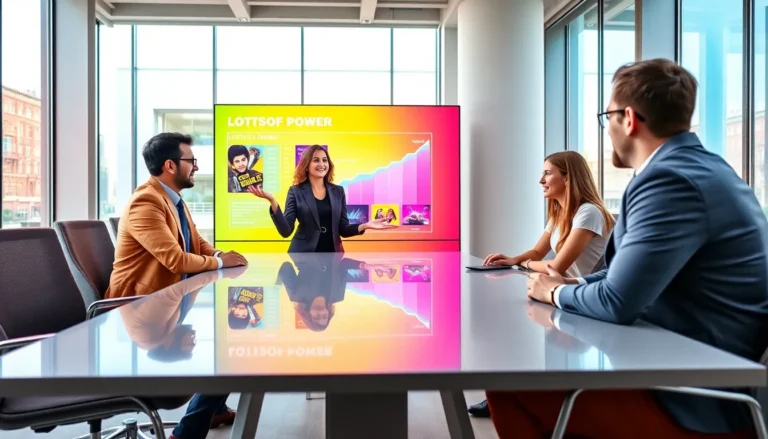In today’s fast-paced world, working from home has become the new norm, and the tiny home office trend is taking the globe by storm. Who knew that a corner of the living room could transform into a productivity powerhouse? With a sprinkle of creativity and a dash of organization, even the smallest spaces can become the ultimate work sanctuaries, proving that size doesn’t always matter.
Table of Contents
ToggleWhat Is a Tiny Home Office?
A tiny home office refers to a compact workspace designed for productivity within limited square footage. This setup allows individuals to carve out functional work areas in smaller homes or apartments. Creative design solutions enhance efficiency in spaces as small as a closet or a corner of a room.
Workspace organization plays a crucial role in maximizing tiny home office potential. Utilizing vertical storage, such as shelves and wall-mounted organizers, can free up valuable floor space. Incorporating multi-functional furniture also helps, with desks that double as storage units or fold away when not in use.
Lighting significantly impacts the atmosphere of a tiny home office. Natural light improves mood and focus, so positioning a desk near a window is advantageous. Task lighting, including desk lamps, can also ensure sufficient illumination for detailed tasks.
Aesthetics contribute to the effectiveness of tiny home offices. Color schemes that promote concentration, like neutral tones or calming hues, help create a professional environment. Personal touches, such as artwork or plants, foster inspiration and make the space feel inviting.
Ultimately, tiny home offices encourage adaptability in work-from-home arrangements. These spaces are not just for traditional office settings; they accommodate various working styles, from remote jobs to creative pursuits. By adopting innovative design strategies, individuals can transform modest areas into productive workspaces.
Benefits of a Tiny Home Office
Tiny home offices offer several significant advantages for those working remotely. Maximizing limited space can enhance productivity and create focused environments.
Cost-Effectiveness
Establishing a tiny home office minimizes overhead costs compared to traditional office setups. Lower expenses stem from reduced rent and utility bills, as working from home eliminates commuting costs. Selecting compact furniture over larger office options also leads to savings. Furthermore, using existing spaces requires no significant renovations, preserving financial resources for other investments.
Space Optimization
Utilizing small areas effectively leads to increased productivity in tiny home offices. Multi-functional furniture serves dual purposes, such as a desk that doubles as a dining table. Creative design solutions, like vertical storage, free up floor space while keeping essentials within reach. Natural light significantly enhances mood and focus, making even the smallest corners inviting and stimulating. Personal touches add character without cluttering, turning confined spaces into engaging work environments.
Design Ideas for a Tiny Home Office
Designing a tiny home office requires maximizing space and functionality. Innovative ideas can transform limited areas into productive workspaces.
Functional Furniture Options
Selecting versatile furniture maximizes efficiency. Desks with built-in storage save space while providing work surfaces. Folding chairs can easily tuck away when not in use, offering flexibility. Consider using wall-mounted tables that fold down, keeping the floor clear. Choosing a compact desk that fits within a corner optimizes workflow while maintaining accessibility. Stools or ottomans often provide extra seating and storage. Prioritizing multi-functional pieces enhances the workspace’s usability.
Creative Storage Solutions
Utilizing vertical space encourages organization. Shelving units that reach toward the ceiling make use of unused areas, storing books and supplies. Over-the-door organizers can hold office essentials, reducing surface clutter. Magnetic strips attached to walls often secure tools and materials, promoting easy access. Consider installing pegboards for customizable storage options that adapt to needs. Boxes or bins under desks provide hidden storage, keeping the workspace tidy. Adopting these solutions maximizes storage potential in tiny home offices.
Tips for Creating Your Tiny Home Office
Creating an efficient tiny home office involves thoughtful design choices that enhance productivity and comfort. These tips aim to optimize the workspace effectively.
Maximizing Natural Light
Natural light improves mood and focus in any workspace. Position the desk near windows to capture maximum sunlight throughout the day. Sheer curtains can diffuse glare while still allowing light to flow in. Mirrors placed strategically can reflect light and create a sense of openness. Consider using light-colored window treatments that brighten the space. Incorporating plants near the window can enhance aesthetics and boost air quality, making the area more inviting.
Choosing the Right Colors
Color selection influences productivity and atmosphere. Soft, muted tones like light blues or greens promote calmness and focus in small offices. Accent walls painted in vibrant colors can inspire creativity without overwhelming the space. Using white or light shades on walls makes the area feel larger and more spacious. Incorporating colored decor or office accessories can add personality without cluttering the environment. It’s essential to find a balance that reflects individual style while enhancing the workspace’s functionality.
Conclusion
Tiny home offices are revolutionizing the way people approach remote work. They prove that even the smallest spaces can foster productivity and creativity. By utilizing smart design choices and maximizing available space individuals can create inspiring work environments that enhance focus and efficiency.
With thoughtful organization and the right furniture anyone can transform a corner of their home into a functional office. The benefits of cost savings and increased productivity make tiny home offices an appealing option for those looking to adapt to the evolving work landscape. Embracing this trend allows for a more personalized workspace that reflects individual style while maintaining practicality.







